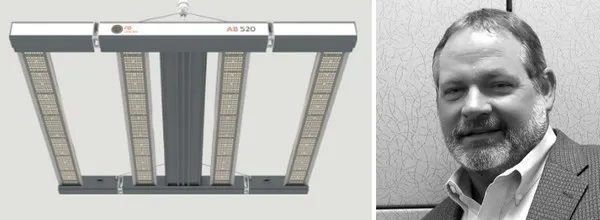“There are no industry-wide standards for grow lights, and there is no official way to measure them. As a result, a supplier could put misinformation on their spec sheets, whether intentionally or accidentally. With third-party testing being done very minimally, there is a lot of disappointment among growers with the quality of grow lights,” says Mark Honeycutt, CEO of AB Lighting. The grow lights manufacturer has been testing all of their products, but Honeycutt explains that they are the exception to the rule. “There are some very important measurements that growers and investors should be making their buying decisions on.” 
Left: AB Lighting’s newest product, the AB520 light. Right: Mark Honeycutt, CEO of AB Lighting
Validating the claims
According to Honeycutt, grow lights are currently only expected to have a DLC certification, which is necessary to get a rebate from the state utility. “That is all that exists today in terms of testing criteria. There is no police, so to speak, on standards for grow lights, and there is no official way to measure them.” As a result, many manufacturers publish their own statistics and specification sheets on their products. “They could put misinformation on there, even if it is done accidentally. They might believe their PPF/PPFD to be a certain amount when it is different in reality. We believe that growers and investors deserve to have the legitimate details of what they are paying for. Therefore, we are big proponents of using test lab data to support one’s claims.”
Honeycutt explains that there are a lot of components that get tested for a specification sheet of a grow light. “However, there are a couple of elements that I think are the most important. The two biggest aspects are PPF/PPFD and efficacy. These have to do with how efficient the light is in terms of how many photons are actually being delivered to the plant. Moreover, it is important to know the quality of the driver. Many manufacturers will use low-quality drivers to reduce costs. Yet the better the driver is, the longer the light will work. The quality of the driver is an important element to having a light that will last a long time.”
Preventing disappointment
At the moment, third-party testing of grow lights is not yet standard practice. Instead, it is being done on an ‘as needed’ basis, says Honeycutt. “By testing all of our products, we are definitely the exception to the rule. Many manufacturers still believe it is unnecessary and that the DLC approval is enough. Yet there is a lot of disappointment in the market with the quality of grow lights. One of the reasons some of our customers have come to us, is because they want to change vendors after experiencing disappointment with their lights and lack of support concerning returns. At AB Lighting, we can provide them with verifiable and objective data on the efficacy of our products so that disappointment is no longer possible.”
Still, it is not as simple as it sounds to convince a grower to purchase your lights, even when you have the objective numbers as proof. “Growers come from all types of backgrounds, and they can’t be experts in everything that they do. Their ultimate skill set is to produce great plants with maximum yields and high-quality harvests. It is quite rare to find a grower who is also a lighting expert. So when it comes to the decision of a lighting purchase, they need to be open to learning about the importance of third-party testing. Therefore, AB Lighting has a very educational approach to selling, to make everyone understand the value of objective data.”
For more information:
AB Lighting
Mark Honeycutt
mark.honeycutt@ablighting.com
www.ablighting.com
